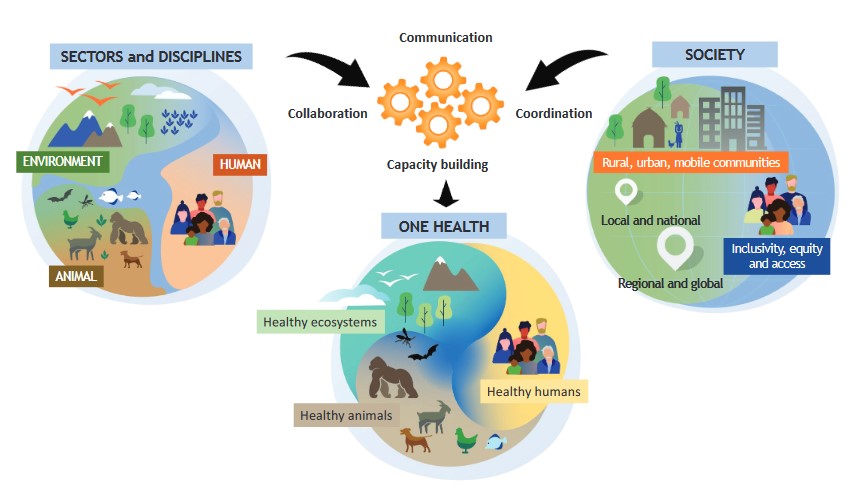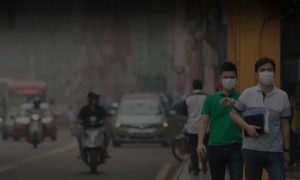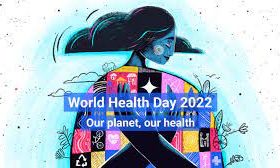Update
World Health Day 2022
7 April is World Health Day, a global health awareness day that draws attention to a health topic of concern to the world. Celebrated every year, it also marks the anniversary of the founding of the World Health Organization in 1948. This year, the theme is "Our planet, our health".
About
World Health Day is a global health awareness day that brings attention to a specific health topic that concerns people all over the world.
This global celebration also marks the founding of the World Health Organization (WHO) in 1948, when the First World Health Assembly was held. The Assembly decided to celebrate 7 April of each year, taking effect from 1950, as the World Health Day. Seen as an opportunity to draw worldwide attention to a subject of major importance to global health, the WHO organizes international, regional and local events on the Day related to a particular theme.
World Health Day is acknowledged by various governments and non-governmental organizations with interests in public health issues, who also organize activities and highlight their support in media reports.
2022 Theme: Our Planet, Our Health
The theme for World Health Day 2022 is Our Planet, Our Health. In the midst of a pandemic, a polluted planet, increasing diseases like cancer, asthma, heart disease, this year’s theme aims to bring attention on the urgent actions needed to keep humans and the planet healthy and foster a movement to create societies focused on well-being.
WHO estimates that more than 13 million deaths around the world each year are due to avoidable environmental causes. This includes the climate crisis which is the single biggest health threat facing humanity. The climate crisis is also a health crisis.
Air pollution, on the other hand, is considered to be the single greatest environmental risk to human health. It is one of the main avoidable causes of death and disease globally, and yet it kills an estimated seven million people worldwide each year.
Healthy societies rely on well-functioning ecosystems to provide clean air, fresh water, medicines and food security. These help to limit disease and stabilize the climate. Meanwhile, the main sources of air pollution and greenhouse gases are often the same. Most actions to improve air quality can also help fight climate change.
Climate Crisis as Health Crisis
Climate change is the single biggest health threat facing humanity (WHO, 2021). The impacts are already harming health through air pollution, disease, extreme weather events, forced displacement, food insecurity and pressures on mental health. Between 2030 and 2050, climate change is expected to cause approximately 250,000 additional deaths per year, from malnutrition, malaria, diarrhoea and heat stress (WHO, 2018). Climate mitigation and adaptation, including the reduction of carbon emissions, are thus essential to decreasing health risks for both our generation and future generations.
Air Pollution
Air pollution is the single greatest environmental risk to human health and one of the main avoidable causes of death and disease globally. According to the WHO, air pollution kills an estimated seven million people worldwide each year and that 9 out of 10 people breathe air containing high levels of pollutants. In addition, air pollution disproportionately affects women, children and older persons. Meeting the goals of the Paris Agreement could save about a million lives a year worldwide by 2050 through reductions in air pollution alone.
One Health
One Health is an approach in which multiple sectors work together to achieve better public health outcomes (WHO, 2017). It is rooted in the recognition that human health and animal health are interdependent and bound to the health of the ecosystems in which they exist (OIE, n.d.). The complex nature of the interactions between people, animals and plants renders this collaborative, multisectoral and transdisciplinary approach critical to addressing future health risks and challenges.

Climate change affects and threatens the social and environmental determinants of health – clean air, safe drinking water, sufficient food and secure shelter – of both humans and animals alike (WHO, 2021). Various species are forced to migrate from their natural habitat, which increases the opportunities for disease to transfer from animals to humans. A One Health Approach is therefore vital in keeping the planet healthy as the health of animals and people depend on a healthy environment.
Health, Environment and Human Rights
In line with the One Health approach, advancing human rights in the context of health and the environment is key in addressing having a healthy people in a healthy planet.
Right to Health and Climate Change
The right to health is an inclusive right, extending not only to health care, but also to the underlying determinants of health, such as access to quality food, safe and potable water and adequate sanitation, healthy occupational and environmental conditions, and access to health-related education and information.
The Special Rapporteur on Health recognizes that climate change has an alarming effect on the right to health, as climate-related changes such as heat, drought, flood, hurricanes, are associated with increased rates of cardiovascular disorders, respiratory, gastrointestinal, and renal problems (HRC/32/23). Not only does it affect physical health, but it also has an impact on a person’s mental health and well-being. As such, addressing the negative impacts of climate change can help in the full realization of the right to health.
Right to a Clean, Healthy, and Sustainable Environment
With the adoption of a resolution recognizing the human right to a clean, healthy and sustainable environment (48/13), the Human Rights Council at its 48th session has now acknowledged that having a healthy environment as a right of all.
This recognition includes the right not to be exposed to a non-toxic environment, as jointly reported the Special Rapporteur on human rights and the environment (SR Environment) and the Special Rapporteur on toxics and human rights (SR Toxics) during the 49th session of the HRC. The report highlights the ongoing toxification of people and the planet, which is causing environmental injustices, where vulnerable and marginalized groups bear a disproportionate burden of the health, human rights and environmental consequences of exposure to pollution and hazardous substances.
This recognition will not only highlight that human rights have to be guaranteed and effective in the face of environmental challenges, but safeguards human health in the process.
Clean Air as a Human Right
Poor air quality has implications for a wide range of human rights, including the rights to life, health, water, food, housing and an adequate standard of living. Air pollution also clearly violates the right to a healthy and sustainable environment.
Air pollution is a preventable problem. The solutions − laws, standards, policies, programmes, investments and technologies − are known. Implementing these solutions will of course entail large investments, but the benefits of fulfilling the right to breathe clean air for all of humanity are incalculable.
In “The Right to Breathe Clean Air” report to the General Assembly of David R. Boyd, UN Special Rapporteur on Human Rights and the Environment (2019), he offers a number of recommendations to States for actions they should consider as part of a national air quality action plan. He also urges businesses to fulfill their responsibility, to contribute to and support efforts to reduce air pollution.
Role of Geneva
Stockholm Convention
The Stockholm Convention on Persistent Organic Pollutants is a global treaty to protect human health and the environment from chemicals that remain intact in the environment for long periods, become widely distributed geographically, accumulate in the fatty tissue of humans and wildlife, and have harmful impacts on human health or on the environment. Exposure to Persistent Organic Pollutants (POPs) can lead to serious health effects including certain cancers, birth defects, dysfunctional immune and reproductive systems, greater susceptibility to disease and damages to the central and peripheral nervous systems. Given their long range transport, no one government acting alone can protect its citizens or its environment from POPs.
Global Alliance on Health and Pollution (GAHP)
The GAHP is a collaborative body made up of more than 60 members and dozens of observers that advocates for resources and solutions to pollution problems. GAHP was formed because international and national level actors/ agencies recognize that a collaborative, multi-stakeholder, multi-sectoral approach is necessary and critical to deal with the global pollution crisis and resulting health and economic impacts.
Health, Environment and Climate Change Coalition (HECCC)
In 2018, the heads of the World Health Organization (WHO), UN Environment and World Meteorological Organization (WMO) launched a new global coalition on health, environment and climate change (HECCC). One of its overall goals is to reduce the annual 12.6 million deaths caused by environmental risks, with a special focus on air pollution.
United Nations Special Rapporteur on the Right to Health
The Special Rapporteur on Human Rights and the Environment is mandated to continue to study the human rights obligation towards the full realization of the right of all to the enjoyment of the highest attainable standard of physical and mental health. The current Special Rapporteur is Tlaleng Mofokeng.
United Nations Special Rapporteur on Human Rights and the Environment
The Special Rapporteur on Human Rights and the Environment is mandated to continue to study the human rights obligations relating to the enjoyment of a safe, clean, healthy and sustainable environment. The current Special Rapporteur, David R. Boyd, has developed various reports, such as “The Right to Breathe Clean Air” and “The right to a clean, healthy and sustainable environment: non-toxic environment“, that highlight the interlinkages between a healthy environment and well-being.
World Health Organization (WHO)
The WHO indicates that the world population is encountering unfamiliar human-induced changes in the lower and middle atmospheres and world-wide depletion of various other natural systems. Beyond the early recognition that such changes would affect economic activities, infrastructure and managed ecosystems, there is now recognition that global climate change poses risks to human population health. Climate change is emerging as a major theme in population health research, social policy development, and advocacy. Consideration of global climatic-environmental hazards to human health will become a central role in the sustainability transition debate.
In terms of air pollution, the First WHO Global Conference on Air Pollution and Health took place in Geneva in from 30 October to 1 November 2018. The WHO also developed the guideline “Health and the Environment: Addressing the Health Impact of Air Pollution“.
World Meteorological Organization (WMO)
WMO advances integrated sciences and services to better manage risks to human health related to climate change, extreme weather and climate, water, air quality and solar radiation. Through the WHO/WMO Joint Office for Climate and Health, they are establishing an online Health and Climate Science Portal, which promotes actionable science for the management of environmental risks to health.
Learning

Climate Change Negotiations and Health
Online Course | WHO

Introductory Course on the International Legal Framework on Transboundary Air Pollution
Online Course | InforMEA

An Introduction to Climate Change and Human Rights
Online Course | UN CC:Learn

Air Pollution Quiz
Quiz | Clean air for blue skies
Resources
- The right to a clean, healthy and sustainable environment: non-toxic environment | Report of the Special Rapporteur on the issue of human rights obligations relating to the enjoyment of a safe, clean, healthy and sustainable environment (A/HRC/49/53)
- Special Report on Climate Change and Health | WHO | 11 October 2021
- Tracking progress on health and climate change | The Lancet Countdown
- Doctors put a price tag on the annual health impacts of climate change. It’s $820 billion. | Grist | 21 May 2021
- WHO Director-General’s opening remarks at Virtual Event on Climate Change and its Link to Health, Labour and Human Rights | WHO | 10 February 2021
- Scientists call for Integrated One Health Approach to Climate, Disease Mitigation | Rizki Fachriansyah | The Jakarta Post | 10 November 2020
- Promoting and protecting health through the UNFCCC | WHO | 1 January 2020
- Climate Change and One Health | Jakob Zinsstag Lisa Crump, et al. | FEMS Microbiology Letters | June 2018
- The Paris Agreement is a Health Agreement – WHO | UN Climate Change | 3 May 2018
- Climate change and health | WHO | 1 February 2018
- The impact of climate change on the enjoyment of the right to health | OHCHR

